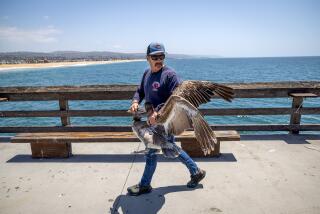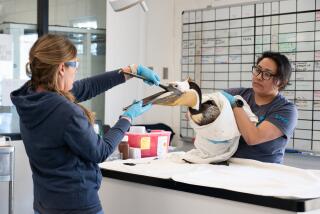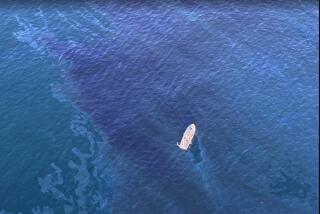Rescuers struggle to save oil-soaked pelicans
Reporting from Queen Bess Island Pelican Rookery â The rocky island off Grand Isle was intended as a haven for brown pelicans, a centerpiece of environmentalistsâ efforts to rescue Louisianaâs state bird from the federal endangered species list.
On Monday, wildlife rescue workers came to the Queen Bess Island Pelican Rookery to capture the giant birds as oil from BPâs blown-out well in the Gulf of Mexico despoiled the stateâs largest pelican sanctuary.
A man in a canoe paddled near the shoreline, nudging the oil-covered birds into deeper water, where big boats motored up, their bird-catching crews leaning over the sides. They cast their nets in quick swoops, then twisted them to snare the pelicans safely inside so they could be lifted from the water and shoved into waiting animal carriers.
None proved easy to catch despite their pitiful condition. At least two tried to take flight but managed only to bounce across the flat surface of the bay. Their oily feet splashed through the water and their wings flapped helplessly.
âThis island is what brought the brown pelican back to Louisiana,â said Hudgins Littleton III, a retired oil worker watching the arrival of rescue boats.
For days, orange booms encircled the rookery as protection against a spill that has broken up into patches and streaks across the gulf. But oily water topped the barrier and spilled through a hole punched by a weekend storm.
Such scenes were repeated throughout the gulf region Monday, while engineers tinkered with a cap diverting oil from the gushing well to a surface ship and drill crews made steady progress on a shaft to intercept the runaway well and plug it sometime in August.
By Monday morning, at least 597 birds had been picked up by wildlife workers in Louisiana, 209 of them dead. Across the waters of four gulf states, the total number of dead birds was estimated at 594.
After a tour of the rookery, Louisiana Gov. Bobby Jindal announced that the Coast Guard had approved a plan to anchor barges and build rock dikes around the barrier island at the mouth of Barataria Bay. The plan âwill allow them to narrow those passages by as much as 70%,â Jindal said.
At the same news conference in Grand Isle, BP Managing Director Bob Dudley said the company would pay $360 million to fund the construction of 45 miles of sand berms off the Louisiana coast. His announcement that BP had made the first $60-million payment was met with applause from locals watching the news conference at the Grand Isle Community Center.
Even as a containment cap installed last week captured more of the leaking oil, the record slick generated by the well blowout has metastasized to what Coast Guard Adm. Thad Allen described Monday as âa massive collection of smaller spills.â
The cap on Monday was capturing an estimated 11,000 barrels of oil per day, a rate expected to increase. Oil will continue to escape the cap until relief wells are completed.
A government panel has estimated the total flow at 12,000 to 19,000 barrels per day, but BP said that cutting a kinked riser pipe before placing the cap could have increased the flow by as much as 20%. Estimates of the leak rate, however, continue to be met with skepticism.
BP Senior Vice President Kent Wells said Monday that the plume of gas and oil swirling around the containment cap is not as thick as it appears to be, and he said that some vents on the cap may be kept open during the pumping process.
By Monday morning, as oil slicks expanded to affect about 120 miles of gulf coastline, the drilling of one relief well had reached about 8,000 feet below the seafloor, while another had reached about 3,000 feet, but they are not expected to be operable until August.
Since the spill began April 20, more than 1 million gallons of oil-breaking chemicals called dispersants have been pumped into the gulf, Allen said.
He said the Coast Guard had conducted drills to prepare for spills in the gulf but had not anticipated one of this scope and at this distance from shore. âI donât think any plan envisioned it would get out that far and disaggregate,â Allen said. âIf anything is taxing our resources, itâs the breadth.â
While BP works to ramp up the collection rate, it is undertaking a plan to use hoses to extract oil and send it to a platform vessel. Wells said the hoses and cap operation would be able to capture 20,000 barrels, or 840,000 gallons, of oil per day.
BP also plans to place a tighter âsealing valveâ over the damaged well.
At a hearing in St. Bernard Parish near New Orleans, members of Congress heard testimony from the widows of two of 11 workers killed when the Deepwater Horizon drilling rig exploded and sank.
âOne way we can hurt BP is to make sure that âBPâ stand for âbills paid,â that the money for families, the money to clean up the gulf, comes out of their pocket, and that we repeal the Death on the High Seas Act,â said Rep. Edward J. Markey (D-Mass). He was referring to the 1920 law that limits liability for wrongful deaths that occur more than three miles out to sea.
âWe have thousands and thousands of people who are out on these rigs, out on the ocean. And there never was any intention for you and people like you not to be able to recover for your families,â Markey told the widows.
Tina Sussman reported from Queen Bess Island, and Christopher Goffard reported from Los Angeles. Times staff writer Bettina Boxall in Los Angeles and Kim Geiger of the Washington bureau contributed to this report.
More to Read
Sign up for Essential California
The most important California stories and recommendations in your inbox every morning.
You may occasionally receive promotional content from the Los Angeles Times.












